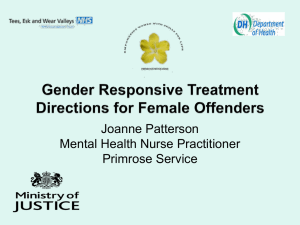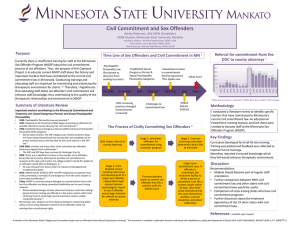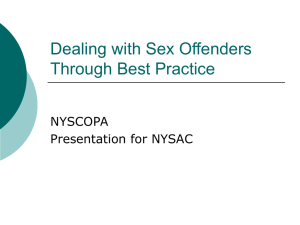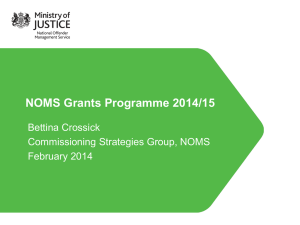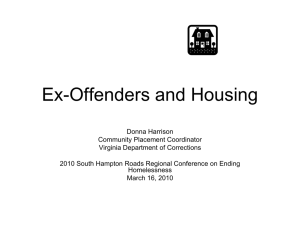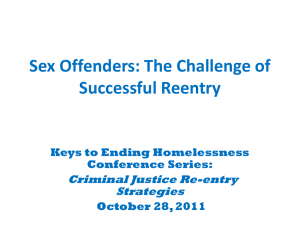Administrative Segregation Management
advertisement
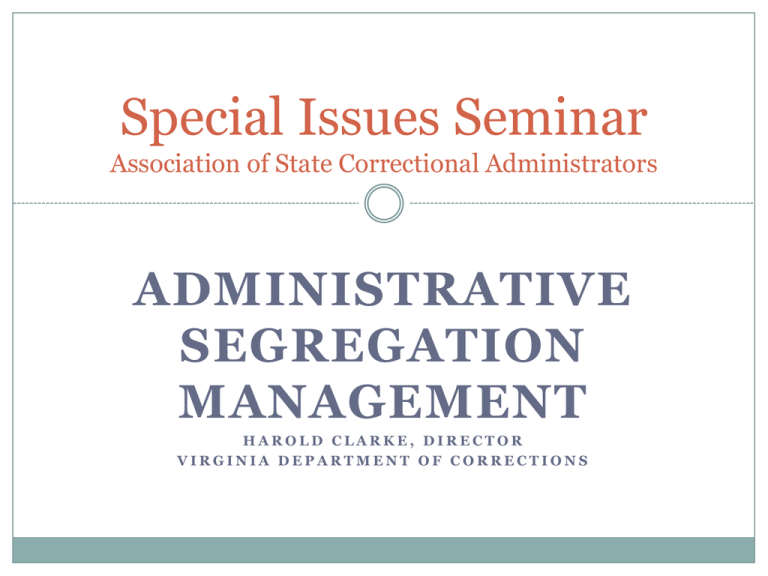
Special Issues Seminar Association of State Correctional Administrators ADMINISTRATIVE SEGREGATION MANAGEMENT HAROLD CLARKE, DIRECTOR VIRGINIA DEPARTMENT OF CORRECTIONS Segregation Reduction Step-Down Plan at Red Onion State Prison and Wallens Ridge State Prison Administrative Segregation Operational Strategy Guided by Evidence-Based Practices Project Goals: Develop a pathway for offenders to successfully step-down from administrative segregation (ad seg) to lower security levels in a way that: maintains public, staff and offender safety applies the principles of evidence-based practices Closely link Red Onion State Prison and Wallens Ridge State Prison for the management and programming of administrative segregation offenders in order to: reduce staff stress by housing multiple security levels at each facility and providing varied post assignment options create a “proving ground” to determine when ad seg offenders are able to function safely in a lower security environment Infuse research and evaluation into the operational design: by setting observable and measurable standards as a means to ensure fidelity assessing outcome effectiveness evaluation and research together will determine areas of strength and areas for adjustment Project Results: Administrative Segregation Reduction: 500 438 400 350 32% 450 457 466 466 441 437 409 382 385 369 355 337 315 300 250 200 Strategies Employed: Utilizing the science of Evidence Based Practices Develop strategy and guidelines for the re-design of administrative segregation Tighten assignment criteria Level S Offenders: Define Types & Criteria for Review Identify Offenders with the potential for extreme and/or deadly violence. (Intensive Management -IM) Identify Offenders with frequent recurring disciplinary violations for assaultive behavior, destruction of state property or other serious & repetitive disciplinary violations. (Special Management –SM) Tightening Assignment Criteria: Assaultive Behavior Assault on Staff Aggravated Assault on Offender Demonstration of or potential for deadly violence in the institution Setting Fire resulting in injury Rioting; Seizing Hostages Commission of Crime of Exceptional Violence and/or Notoriety Serious Disciplinary Behavior (represents a threat level too great for the safety and security of a lower level institution) Escape Risk - requiring maximum security supervision Identifying Long Term Offenders: Intensive Management - IM Potential for extreme and deadly violence History indicates willingness to carry out serious or deadly harm Institutional charges with intent to seriously harm or kill staff or offenders Offenders with high escape risk High Profile or Notorious Crimes Identifying Repetitive Offenders Special Management - SM Assignment Criteria: Frequent, recurring disciplinary violations at lower security levels resulting in harm to staff or offenders – without intent for serious harm or intent to kill Pattern of repeated disruptive behavior resulting in significant property damage Offenders who intentionally commit disciplinary violations with the goal of remaining segregated Interventions at lower security levels ineffective Pathways to Lower Security: Increased Responsible Behavior Reduced Disciplinary Infractions Evidence-Based Programming Incentives Special Management – A Three Tiered System Programming/Assessment: COMPAS URICA computerized decision-support system for treatment planning and management Responsiveness to Change Case Plan and Management Path Selection Criminal Thinking Scales Introduced to develop a baseline of criminogenic thinking TCU Criminogenic Scales -Social functioning -Motivation -Engagement -Psychological functioning -Decision Making Programming Objectives: Motivate offenders to participate in the step-down program which includes three areas of commitment by the offender: 1. Program participation goals 2. Disciplinary Violation goals 3. Responsible behavior goals (e.g., personal hygiene, standing for count, cell compliance, deportment—satisfactory rapport) Participation is voluntary Offenders who choose to participate in the step-down program earn increasing privileges and eligibility for classification reduction and transfer to lower security level facilities Available Privileges: Earn Incentives/Privileges Incrementally such as: Increased commissary spend limit Increased check-out number of books from library Eligibility for institutional jobs Increased visitation & eligibility for video visitation Increased phone call frequency Programming out of cell Programming Phase 1: Therapeutic Modules Counselor & Treatment Officer Facilitation Challenge Series Interactive Journals (addressing errors in thinking and building healthy support systems) Controlled Movement to Program Treatment Officer Facilitation Programming Phase 2: Security Programming Chairs Establish Program Goals Programming – Security Level 6: Phase 1 & 2 Unrestrained Thinking for a Change Small Group Pod Recreation Group Meals Intensive Management(IM)/ Special Management(SM) Pathway Program Location IM Management Path IM Program Delivery SM Management Path SM Program Delivery IM 0 In - Cell SM 0 In - Cell IM 1 Therapeutic Modules SM 1 Therapeutic Modules IM 2 Program Chairs SM 2 Program Chairs SL 6 IM Closed Pod Program Chairs SL6, *SIP, **SAM, Step Down Small Groups Level 1 SL6 IM Closed Pod Level 1 Small Groups SL6, *SIP, **SAM, Step Down Small Groups (Double cell) Level 2 Level 2 *SIP - Secure Integrated Pod Housing for offenders with a pattern of intentionally committing numerous minor disciplinary offenses to remain in segregation. **SAM – Shared Allied Management Housing for offenders that are easily bullied, manipulated, taken advantage and / or lower cognitive processing. Five levels of Review: Regional Operations Chief, External Review In advance of offender assignment to administrative segregation (Level “S”) Reduction from Security Level 6 to Security Level 5 Institutional Classification Authority Review minimum of every 90 days (or more frequently as necessary) while assigned to ad segregation Ensures classification is consistent with policy Refers appropriate offenders to Dual Treatment Team Reduction from Security Level S to Level 6 Reduction from Security Level 6 to Security Level 5 Five levels of Review (continued): Dual Treatment Team Review Wardens Review Assign offenders to appropriate Management Path – IM or SM Referring offenders to Warden for advancement to Security Level 6 Review and Recommend for Level S For reassignment from Level S to Level 6 For reassignment from Level 6 to Level 5 For transfers to other Level 5 or lower facility Agency Annual External Team Review Includes review of the following: --Is the offender appropriately assigned to Level “S”? --Does the offender meet the criteria for the Intensive Management or Special Management path to which they are assigned? --Has the Dual Treatment Team made appropriate decisions to advance the offender through the step-down process? Summary of Reviews Assignment: Referring Facility Warden Review Central Classification Review (Headquarters) Ad Seg Facility Warden Review Regional Operations Chief Approval Facility Reviews: Minimum 90 day Institutional Classification Authority Weekly Review of Case Plan Management Referral to multi-disciplinary Dual Treatment Team Review Case Plan management in its entirety The Facility Dual Treatment Review Team consist of : EBP Manager; Program Manager, Unit Manager, Intelligence, QMHP, Counselor, Correctional Officer, Medical External Reviews: Agency annual review of all offenders assigned to administrative segregation to ensure: Is the offender appropriately assigned? Does offender meet the criteria for the management path they are assigned? Review Action of dual treatment team Includes: Chief of Corrections Operations; Regional Operations Chief; Regional Administrator; Chief of Classification, Director of Programs and Reentry; Statewide EBP Manager; Director of Mental Health Services, Director of Psychiatric Services; Chief Physician


